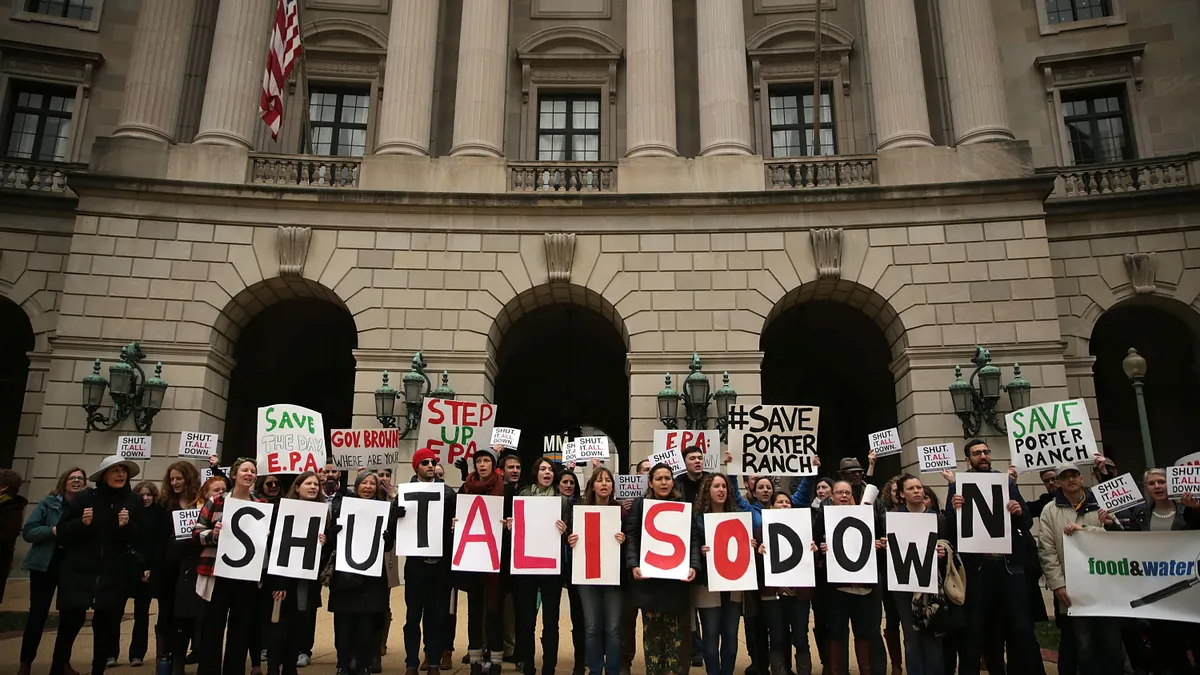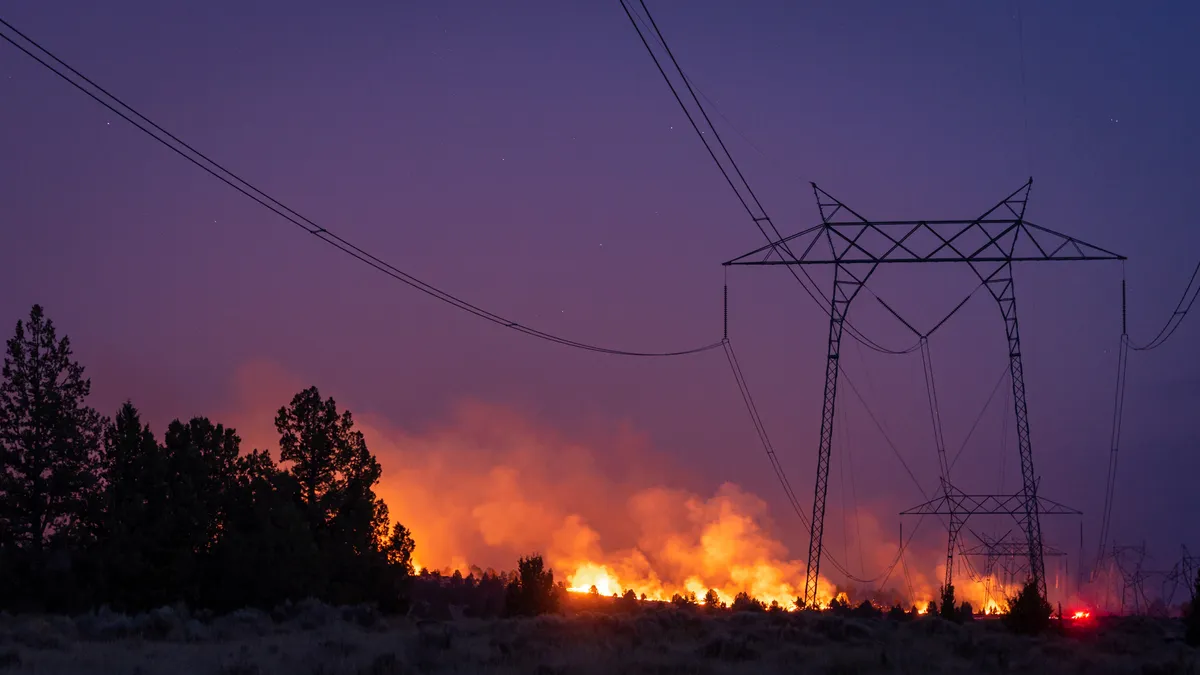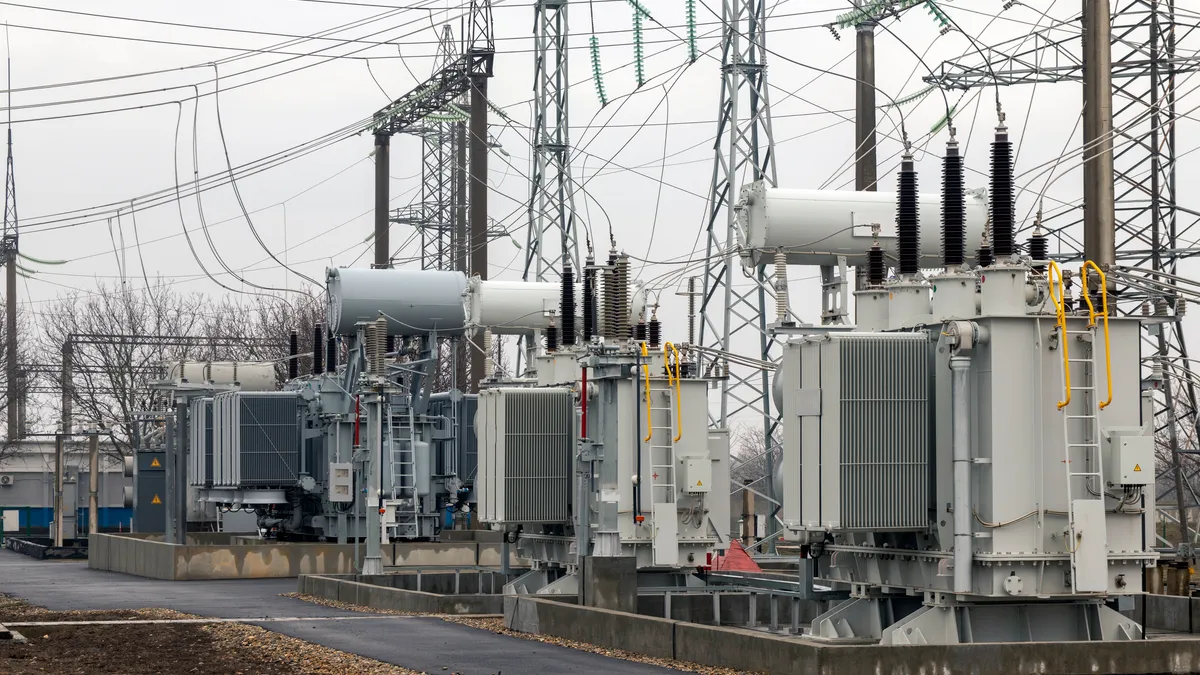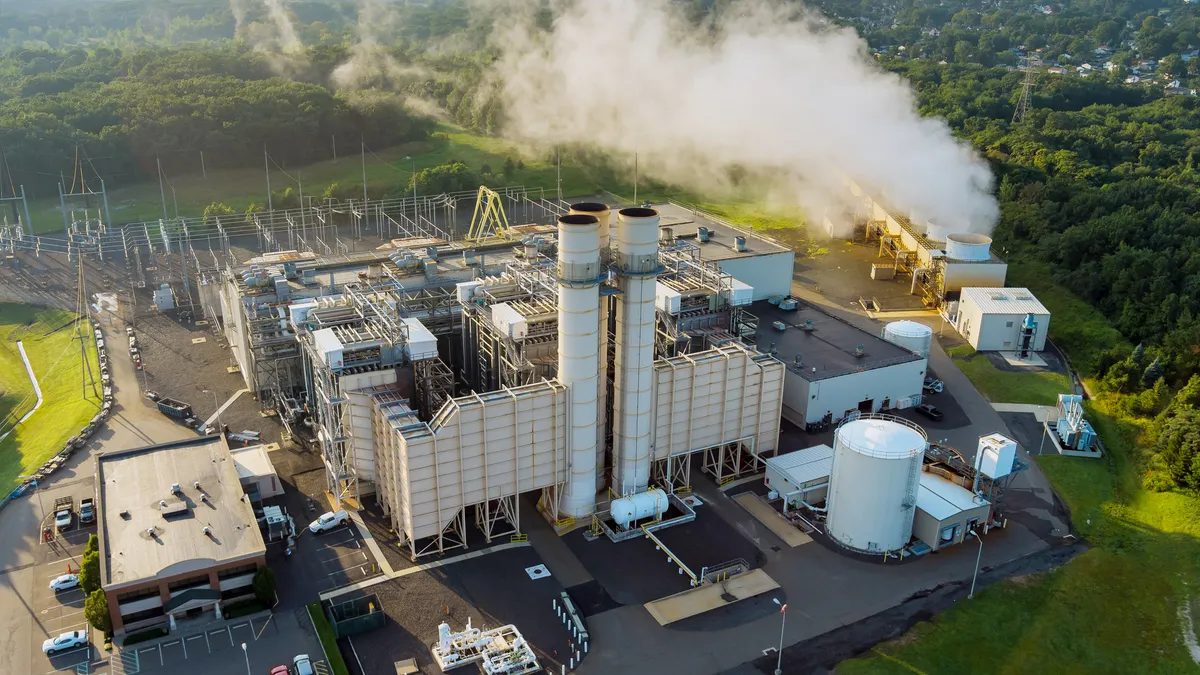California regulators are taking a closer look at the possibility of closing one of the nation's largest natural gas storage facilities, located just northwest of Los Angeles, in an effort that some experts think could offer valuable lessons on a broader transition away from the fuel.
The Aliso Canyon natural gas storage field, operated by Southern California Gas Company (SoCalGas), has the capacity to store 86 billion cubic feet of natural gas and plays an important role in maintaining energy reliability, especially in the L.A. Basin.
But six years ago, the facility experienced a leak that released more than 100,000 tons of methane into the air, prompting the temporary relocation of more than 8,000 households and leading then-Gov. Jerry Brown, D, to declare the incident a state emergency. In the wake of the leak, the California Public Utilities Commission (CPUC) opened a proceeding to investigate the possibility of either reducing or entirely eliminating the use of the storage field, without compromising on reliability.
Part of the pathway to reducing Southern California's dependence on the Aliso Canyon facility will be to explore reductions in natural gas usage, including weaning off gas-fired generation, said Seth Hilton, partner at Stoel Rives. And if California can figure that out, it could serve as a model for other areas that are looking to do the same.
"It definitely could be, and probably should be [a model], if California is successful in reducing the amount of natural gas it relies on and gas storage that it needs," Hilton said. "It's either a disaster and it's a model — or it works, and it's a model."
California's reliability challenges
Closing down the Aliso Canyon storage field without a proper plan in place could have broader implications for electric and gas reliability, Hilton said, from the potential for local gas shortages — for heating and other end-use purposes — to a hit to natural gas-fired electric generation that could impact the system overall.
Part of the challenge is that as California experiences hotter summers due to a changing climate while simultaneously shifting to renewables, its key focus will be on meeting the net demand peak period, which tends to occur later in the evening, than the total demand peak. While the state is installing more energy storage to help with that net peak period, it still leans on gas-fired generation, Hilton said. And facilities like Aliso Canyon also help protect against events like the recent reliability crisis in Texas, which could impact the flow of gas from other states into California.
Additionally, having in-state underground gas storage provides a layer of protection to SoCalGas' system, which is at the end of the line for multiple pipelines that bring gas into California, the utility said in a July filing with the California Energy Commission (CEC). If a wildfire, freezing temperatures or other weather conditions were to affect the supply of gas to the state, underground storage is "the primary safeguard against curtailments and the significant safety and economic impacts that can result," the utility stated.
"We've already spent a lot of time recognizing the immense dependency that we have on Aliso, and I really didn't want to spend all this great time… looking at the alternatives and not actually do come up with a plan..."

Martha Guzman Aceves
Commissioner, California Public Utilities Commission
Another difficulty in shutting down and replacing the storage field is the particular complexities of studying the L.A. Basin area. The region faces multiple transmission constraints, Neil Millar, vice president of transmission planning and infrastructure development at the California Independent System Operator (CAISO), said at a CEC workshop in early July.
And while there are opportunities for energy storage resources to replace gas-fired generation in the region, that analysis "has to take into account the charging requirements, which could be met either from importing energy from outside of the area or from other in-basin gas-fired generation in the off-peak hours," Millar said. "So there is still a potential there for the use of gas-fired generation for charging... ."
'Certain communities in our state bear the brunt'
When the CPUC first opened the proceeding, in 2017, to explore the feasibility of shutting down Aliso Canyon, regulators envisioned a two-phase process — developing the analysis and scenarios within which to evaluate the impact of closing down or reducing the use of the facility, and then actually evaluating those impacts.
In December 2019, the agency added a third phase, which involved bringing on board an expert consultant to identify the resource portfolio and infrastructure — including renewables, energy efficiency, storage, demand response and additional gas transmission — that could help entirely replace the Aliso Canyon field. The analysis is focused on two time horizons: 2027 and 2045.
Early this year, CPUC Commissioner Martha Guzman Aceves took over the proceeding, replacing Commissioner Liane Randolph, who has since gone on to head the California Air Resources Board. Her biggest priority now, she told Utility Dive in an interview, is to get that study completed in a way that is robust, comprehensive and specific, with actual estimates of costs and feasible timelines.
A key part of her thinking around the question of Aliso Canyon is the impact that the facility has on the communities who live around it.
"Certain communities in our state bear the brunt — and the communities around Aliso Canyon are those, in this instance," she said.
Guzman Aceves issued a ruling in July expanding the scope of the commission's effort to also look at what steps it would need to take if it does authorize closing down the Aliso Canyon facility — including what to replace it with, when to do so, what directions to provide utilities and how to begin implementing the closure.
"[W]e're actually going to come up with a plan here. We've already spent a lot of time recognizing the immense dependency that we have on Aliso, and I really didn't want to spend all this great time… looking at the alternatives and not actually... come up with a plan, an actionable plan around it," she said.
How — and when — to replace the Aliso Canyon storage field
FTI Consulting and Gas Supply Consulting, the companies that the CPUC brought on board to study resource alternatives to the Aliso Canyon storage field, are evaluating four investment portfolios as part of their analysis, as outlined in a March filing — investments in new pipeline infrastructure; gas demand-side strategies, like demand response, energy efficiency and electrification; increasing the build out of renewables that California is currently envisioning under its integrated resource planning process; and adding transmission capacity to the system. The consultants intend to look into these options and use that analysis to craft a fifth portfolio, designed to include elements from the first four, down the line. Their study is expected to be completed later this year.
"[T]he more renewables you put onto the market, into the system, the more volatility you carry forth and bring forth into the system, which requires some sort of offsetting resource to address that volatility."

Jonathan Peress
Senior Director of Business Strategy and Energy Policy, Southern California Gas Company
Utilities, clean energy groups and other stakeholders have different perspectives on the timeline for weaning the system off, and replacing, the Aliso Canyon field. Jonathan Peress, senior director of business strategy and energy policy at SoCalGas, told Utility Dive that the need and value of storage is increasing, not decreasing, amid California's shifting energy landscape.
"It's increasing because the more renewables you put onto the market, into the system, the more volatility you carry forth and bring forth into the system, which requires some sort of offsetting resource to address that volatility," Peress said.
Peress also pointed to decreases in available power imports and hydropower, as well as multi-day weather events, all of which will benefit from in-market stored energy.
"So the trendline is that Aliso [Canyon] and storage have become more critical and important resources over the past few years, as opposed to the converse," he said.
SoCalGas has been looking at clean fuel alternatives to Aliso Canyon, but deploying those solutions will take time, he said.
"As we decarbonize, looking at some of those other options, including hydrogen storage for example, would be appropriate," Peress added.
Other stakeholders see different avenues. California could address the need for the storage field by focusing on reducing the demand for gas in the state, V. John White, executive director of the Center for Energy Efficiency and Renewable Technologies, said. Efforts like electrifying buildings and installing more renewables and storage can make a big dent in that demand over the next five or ten years, White added. He also sees potential for green hydrogen to reduce gas demand in the industrial sector.
"The technology of making hydrogen from renewable electricity is coming along nicely and could be a control strategy in the latter part of this decade to begin moving some of that industrial demand off the gas system, and on to the electric system," he added.
One possible strategy to replace Aliso Canyon, endorsed by the consumer and environment-focused non-profit Protect Our Communities Foundation, is to use minimum local generation measures on certain winter days of the year. Under this approach, the commission would require that on peak cold days, most electricity be delivered to Southern California via transmission lines that tend to be under-utilized in the winter, Tyson Siegele, energy analyst with the foundation, explained. That approach was originally outlined in a 2016 report from California energy agencies, the Los Angeles Department of Water and Power and SoCalGas.
"You could almost completely eliminate the gas generation on those peak cold winter days in Southern California if you were to use the electric transmission at its peak capacity, to bring in as much electricity as possible to Southern California, either from Northern California or from out of state," he said.
Regulators can also capitalize on system-wide reliability procurement orders — like the 11.5 GW of clean energy resources recently approved by the CPUC — by targeting them at specific regions, said Matt Vespa, senior attorney with Earthjustice.
Broader lessons learned
None of these solutions are without their own challenges. More electrification means increasing peak day and peak hourly takes from the gas system for contingency and high demand periods, SoCalGas' Peress said, adding that "the clear consequence of that is electrification enhances the need for and value of [gas] storage — not diminishes it."
On the other hand, Siegele pointed out in an email that California has seen over 900,000 new electric vehicle sales between 2010 and now, but peak electric demand and total annual electric demand have not seen any growth despite this electrification. The state could also see about 1,200 MW of behind-the-meter solar installations — depending on the net energy metering policy it lands on — which could reduce the need for gas generation too, he said, especially since more of these installations are being coupled with batteries.
Siegele also noted that electrifying residential space heating will decrease gas use, since heat pump space heaters are about three times more efficient than high-efficiency gas space heaters and because as of 2019, California got only about 34.2% of its electricity from gas-fired generators. The new clean resources ordered by regulators in the last couple of years will also reduce the percentage of gas used in the state's electricity generation, Siegele said.
At the CEC workshop last month, CAISO's Millar raised similar concerns that electrification could reduce the end-use consumption of gas but would shift some of that demand to the generation side and possibly cause a sudden uptick in electricity demand forecasts, he said.
"We need the forecasting to take into account the possibility of an uptick from electrification strategies, a targeted strategy of gas-fired generation reduction, and [then] use that for the basis for getting on with the transmission development into the area," he said.
“We're going to have a good precedent there in terms of the map, and what we assume the spikes are in those times of need, when we draw on it."

Martha Guzman Aceves
Commissioner, California Public Utilities Commission
The CPUC is still in the early stages of navigating these questions, but stakeholders think the answers could provide broader lessons learned for the state — and other states — on the need for and role of gas amid a broader energy transition.
If California is able to displace fossil fuels with a combination of wind, geothermal, solar, storage, demand response and other resources, "we don't need to go as far on the gas bridge as we used to think," CEERT's White said.
SoCalGas' Peress also sees the potential for broader lessons learned from the CPUC's effort. The proceeding is starting to scratch the surface of what economy-wide decarbonization requires, he said.
"So if the proceeding ends up being an opening to a broader conversation of the nature of the infrastructure, of the gaseous fuels, of the role of renewables, electrification — then that will be beneficial. All of those resources have roles, including storage," he said.
Commissioner Guzman Aceves is hesitant to call the proceeding precedent-setting.
"When you think about transitioning off gas in a way that's not regressive, and in a manner that's not disruptive, both on the gas and electric side, getting rid of storage first is probably not how you want to go about it. I mean, it's like we're getting rid of our savings account," she said. "However, that savings account has a bad history, created a lot of damage, and the Legislature and two governors have told us we need to really focus on how we close it."
But she does think the proceeding could offer some lessons by quantifying what it means to get off gas-dependent electric generation as well as cutting enough gas heating to reduce the state's dependency on Aliso Canyon.
"We're going to have a good precedent there in terms of the map, and what we assume the spikes are in those times of need, when we draw on it," she said.
The commission's effort to ensure enough power capacity inside the dense L.A. Basin region could also offer lessons, Guzman Aceves said.
"Where do we get that local source of electricity?... If we're going to be resilient, a lot of that needs to be local, and how do we do that with such a dense, geographical area?" she asked.























